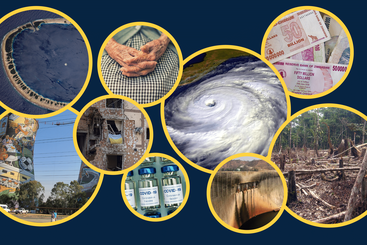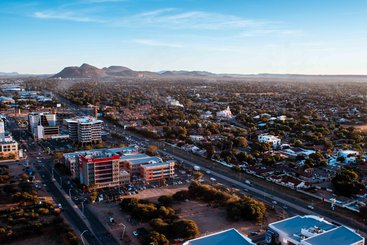Delivered in March, Malawi Finance Minister Sosten Gwengwe’s 2023 budget statement carried a somewhat foreboding title – ‘Sacrificing today for a better tomorrow’ – with the question of how to address the country’s debt burden constituting a central theme.
This issue is shared by other countries in the Southern Africa Development Community (SADC): Malawi, Mozambique, Zambia and Zimbabwe are all classified by the International Monetary Fund (IMF) and the World Bank as being in debt distress.
SADC countries, with debt-distressed countries in dark blue
Managing multiple crises
These countries are among the poorest in the East and Southern Africa region. Poverty rates are considerably higher than the regional average in Malawi, Mozambique and Zambia, and rose significantly in Zimbabwe from 22% in 2010 to 40% in 2019.
Economic fragility has been compounded by global and regional shocks. Covid-19 dented global growth, with valuable tourism revenue still recovering in these countries, while long-lasting lockdowns in China reduced demand for commodities.
As well as draining foreign exchange reserves, the war in Ukraine has pushed up the price of food and other products such as fertiliser and fuel. Coupled with bad monetary policy, this reality saw Zimbabwe’s inflation soar to 285% in August 2022; it remains high.
Year-on-year inflation, annual (%)
Droughts have impacted harvests and have caused water levels in dams – like the one on Lake Kariba – to plummet, affecting electricity production. Cyclones (such as Freddy in early 2023) have devastated both Mozambique and Malawi. Moreover, Mozambique continues to battle an Islamic insurgency in the north-east of the country that has displaced almost 1 million people.
The path to debt distress
The most recent budget speeches were made at a time when all four countries were formally classified as being in debt distress, with current levels of debt deemed to be unsustainable by the IMF and the World Bank. According to the IMF, debt-to-GDP ratios ranged between 64% (Malawi) and 119% (Zambia) in 2021 (the latest IMF data on debt by creditor is available up to 2021).
Debt-to-GDP ratio by country, 2010 to 2021
While recent external shocks have not helped, each country had a prior history of overborrowing, and both Mozambique and Zimbabwe were already in debt distress before the Covid-19 pandemic:
- Zimbabwe has been in default for some time and has long-standing arrears with multilateral lenders, a situation made worse by currency depreciation and hyper-inflation. Furthermore, the government created a large unfunded liability in the form of a Global Compensation Deed which promised to compensate farmers displaced in the early 2000s;
- After being hailed as a post-civil war success story, Mozambique has since descended into crisis following the 2016 ‘hidden debt’ scandal when over $2 billion of undisclosed debt – largely off-budget – was discovered, leading to donor distrust and a fall in foreign aid;
- Following the ‘Cashgate’ scandal, donor support fell in Malawi, leading the country to fill the gap with non-concessional borrowing which worsened public finances;
- Zambia relied on non-concessional borrowing to invest in large infrastructure projects, which did not yield significant returns in the timeframe needed to repay the debt.
The international response
Mozambique and Zambia started IMF Extended Credit Facility (ECF) programmes in 2022, while Malawi received emergency Rapid Credit Facility support via the IMF’s Food Shock Window. Zimbabwe, in contrast, is not eligible for IMF lending, since it still has long-standing arrears owed to international finance institutions.
All four countries also benefitted from the G20’s Debt Service Suspension Initiative, but debt restructuring has proved to be protracted in light of an increasingly complex combination of creditors.
While Zambia recently reached a deal to restructure its debt, Malawi is still in talks with creditors. However, Afrexim Bank (which alongside the Trade and Development Bank made up 65% of Malawi’s external debt service in 2022) recently expressed support for debt restructuring, which would open the door to access to support via the IMF’s ECF.
Debt by creditor type, as share of GDP
2023 budget speeches
This combination of crises and international pressures shaped the context for national budgets in 2023.
| Country | Minister | Fiscal year | Budget speech date |
|---|---|---|---|
| Zambia | Situmbeko Musokotwane | January-December | 30 September 2022 |
| Zimbabwe | Mthuli Ncube | January-December | 24 November 2022 |
| Mozambique | Ernesto Tonela | January-December | 8 December 2022 |
| Malawi | Sosten Gwengwe | April-March | 2 March 2023 |
The objective of debt reduction was particularly evident in Malawi and Zambia’s budget speeches. Mr Gwengwe declared that ‘the pace of borrowing […] is clearly unsustainable and needs to be curtailed’. The theme of debt was also prominent in Zambia, where Finance Minister Situmbeko Musokotwane recognised that ‘the country is under debt distress’ and should convince the IMF that it ‘has got its act together’.
Importantly, the desire to raise economic growth rates competed with debt as a central theme in the budget speeches. Zambia’s budget speech was entitled ‘Stimulating Growth for Improved Livelihoods’, while Zimbabwe’s went by the name ‘Accelerating Economic Transformation’. Mozambique’s speech did not have an explicit title or theme but continued to implement growth-enhancing measures from the government’s 2022 economic strategy, the Economic Acceleration Package (PAE – Pacote de Medidas de Aceleração Economica).
Raising revenue and pushing for growth
Despite the calls to tackle debt, the main tax measures in the 2023 budgets were focused on boosting economic growth.
In Malawi’s budget, for example, the government committed to remove the top 40% tax bracket from PAYE to align with other income taxes and create a new category of ‘mega farms’ which will be tax-exempt for up to 10 years. Zambia, concerned that its copper output has plateaued (unlike in the neighbouring Democratic Republic of the Congo), is reforming its mineral royalty regime, with tax rates now applying only to each marginal price band rather than the aggregate. It has also reduced the lowest marginal rate from 5.5% to 4% at an estimated cost of 2.8 billion kwacha.
Mozambique’s focus is on harnessing income from its new Liquified Natural Gas (LNG) projects, the first of which started production in late 2022. The government is setting up a new Sovereign Wealth Fund which will receive 40% of gas revenues (with the rest flowing straight into the state budget) in order to provide greater stability and sustainability to government revenue and the macroeconomic environment. Additionally, Mozambique is reducing the VAT rate by 1 percentage point to 16% (to bring it in line with neighbouring countries) while also removing a number of VAT exceptions – presumably to keep revenues buoyant.
Revenue and expenditure as a share of GDP
Containing expenditure
As part of its agreement with the IMF, Zambia has agreed to a significant reduction in primary domestic expenditures, as well as a reduction in total central government expenditure from 29.8% to 26.0% of GDP between 2019 and 2026. The Malawi programme also seeks to reduce primary domestic expenditures by around 1.8% of GDP from 2022/23 levels, while the adjustment in Mozambique looks like it is intended to be front-loaded with a cut of 2.3% of GDP in domestic primary expenditure from 2022 to 2023, after which it will remain largely unchanged as a share of GDP until 2028.
This partly explains the significant changes in real terms spending announced in the Mozambique and Zambia budgets. However, the speeches offered other important insights into where pressures are arising, including in the wage bill. In Mozambique, the government introduced a standardised pay scale across the public sector to improve pay transparency and mobility (one of the measures of the PAE). The government had to temporarily increase the wage bill to ensure no civil servants were made worse off by the change – with long-term aims to reduce the wage bill from 13.4% of GDP in 2023 to 11.1% in 2025.
Containing wage expenditure at a time of high inflation was also a challenge in Malawi, where a pay rise of 8% for civil servants was implemented in tandem with the introduction of a transport allowance. Zimbabwe, on the other hand, announced curbs on travel expenditure, recruitment freezes and a prioritisation of ongoing infrastructure projects over new projects – especially the completion of the Hwange 7 and 8 thermal plant expansions. Some announcements, such as Zambia’s new Public Financial Management Strategy, did not require additional spending commitments.
Health and education
The Covid-19 pandemic had a severe impact on early childhood development and education and highlighted the need to invest in resilient health systems. Despite fiscal pressures, all speeches highlighted the large share of the budget allocated to social spending.
In practice, however, the main announcements came from Zambia, which is significantly increasing funding in these sectors due to rising wage costs driven by recruitment. The country plans to recruit an extra 3,000 health sector personnel – on top of the 11,200 recruited in 2022 – while it also expects to hire an additional 4,500 teachers.
In 2023, Zimbabwe significantly increased its education budget and has committed to reach a 20% share (as per the Dakar recommendation) by 2025. In Malawi and Mozambique, health and education spending shares are either stable or decreasing.
Budgeted health and education spending as a share of total expenditure (%)
Addressing the climate crisis and conflict
The climate crisis and natural disasters are key vulnerabilities in the region that have affected some of the budget allocations: Malawi’s ‘mega farm’ legislation can be thought of as strengthening an agricultural sector overly reliant on rainfall, while Zimbabwe is prioritising the Hwange 7 and 8 thermal plants because of the vulnerability of its dams to drought. Additionally, Malawi had to amend its budget in light of Cyclone Freddy, increasing the maintenance budget for its Roads Authority by 66% and investing in two search-and-rescue helicopters.
Mozambique’s conflict in the north-east is another serious vulnerability that has devastated an entire region and threatens the viability of crucial gas deposits. The government announced that 10% of gas revenues in 2023 would go straight to the Cabo Delgado region as a way of ensuring that local communities reap the benefits of these projects.
Questions for the years ahead
All four countries are engaging in measures to bring public debt under control. However, this means it is difficult to invest in education and health at a time when these crucial sectors are still recovering from the Covid-19 shock and high inflation continues to impact standards of living.
Climate change adaptation and investing in low-carbon energy production also require significant investments that are hard to achieve in low-income countries, especially given the debt burden and rising cost of capital. A critical question will be whether sources of financing can be found for investment in these areas.
This is particularly important in the context of tightening aid budgets in the Global North – in Mozambique and Malawi, net Official Development Aid generally represented more than 10% of GNI between 2010 and 2021.
Part of the answer will lie in institutional reforms to keep expenditure in check, widen the tax base and expand the use of appraisal to prioritise investments. Provided their revenue is managed correctly and the conflict in Cabo Delgado is kept in check, the new LNG projects in Mozambique could bring in considerable income to invest in much-needed public services.
It remains to be seen whether governments can actually execute their budget plans as announced. In most lower-income countries, budget estimates are rarely a reliable guide to what gets raised and spent. Mozambique’s 2022 expenditure was 33.1% instead of 40.1% of GDP – in part because of higher GDP growth and inflation, but also partly due to lower investment than was initially budgeted (only 61% of the investment budget was executed).
Ultimately, however, the international community must step up its support and relieve the worst of the fiscal pressures in countries (Zimbabwe excepted) where more than 60% of the population lives on less than $2.15 per day.


